|
|
 |
Fiche d'espèce de Copépode |
|
|
Calanoida ( Ordre ) |
|
|
|
Clausocalanoidea ( Superfamille ) |
|
|
|
Scolecitrichidae ( Famille ) |
|
|
|
Scaphocalanus ( Genre ) |
|
|
| |
Scaphocalanus brevicornis (Sars, 1900) (F,M) | |
| | | | | | | Syn.: | Scolecithrix brevicornis Sars, 1900 (p.46, Descr.F, figs.F); T. Scott, 1902 (p.452, figs.M.), Rem.); Mrazek, 1902 (p.522); Issued from : O. Tanaka in Publ. Seto Mar. Biol. Lab., 1961, IX (1). [p.170, Fig.117].
Amallophora brevicornis : Sars, 1902 (1903) (p.53, figs.F, 164 : Rem.M); Damas & Koefoed, 1907 (part., p.400, tab.II);
? Scolecithrix gracilipes Farran, 1908 b (p.52, figs.F);
Scaphocalanus minuta Tanaka, 1937 (p.262, Descr.M, figs.M);
Amallothrix brevicornis : Wilson, 1932 (p.20); Lysholm & al., 1945 (p.28);
no Scaphocalanus brevicornis : Farran, 1929 (p.209, 248, figs.F, Rem.); Vervoort, 1951 (p.113, figs.F); 1957 (p.107, figs.F,M); Tanaka, 1960 (p.42, figs.F); Bradford, 1970 a (p.356, figs.M); 1971 b (p.23, figs.F,M); 1973 (p.143); Bradford & al., 1983 (p.93, 95, Rem., figs.F,M); ? Björnberg, 1973 (p.331, 389); Arcos, 1976 (p.85, Rem.: p.95, Table II, fig.18); ? Voronina & Kolosova, 1999 (p.71);
? Scolecithrix glacialis (M) : Wolfenden, 1911 (p.251, figs.M) | | | | Ref.: | | | With, 1915 (p.192, figs.M, Rem.F,M); Farran, 1926 (p.258, Rem.); Rose, 1933 a (p.149, figs.F); Brodsky, 1950 (1967) (p.253, figs.F,M); C.B. Wilson, 1950 (p.326, figs.F,M); Tanaka, 1961 a (p.169, figs.F,M); Vidal, 1971 a (p.14, 24, figs.F,M); Björnberg & al., 1981 (p.639, figs.F); Park, 1982 (p.76, 99: Rem.); Gardner & Szabo, 1982 (p.284, figs.F,M); Chihara & Murano, 1997 (p.900, Pl.172: F,M); Bradford-Grieve & al., 1999 (p.881, 932, figs.F,M, Rem. p.932: M); Vives & Shmeleva, 2007 (p.755, figs.F,M, Rem.) | 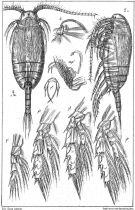 issued from : G.O. Sars in An Account of the Crustacea of Norway. Vol. IV. Copepoda Calanoida. Published by the Bergen Museum, 1903. [Pl. XXXVI]. As Amallophora brevicornis. Female. Nota: mp1 = Mx2.
|
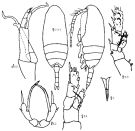 Issued from : K.A. Brodskii in Calanoida of the Far Eastern Seas and Polar Basin of the USSR. Opred. Fauna SSSR, 1950, 35 (Israel Program for Scientific Translations, Jerusalem, 1967) [p.253, Fig.160]. Female (from NW Pacif.): habitus (dorsal and lateral left side); R, rostrum; S1, P1; S2, P2; S5, P5. Male: S5, P5.
|
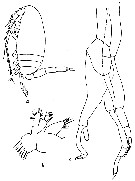 issued from : R.N. Wolfenden in Die Marinen Copepoden der Deutschen Südpolar-Expedition 1901-1903, 1911. [p.251, Fig.30]. As Scolecithrix glacialis With doubt. Male (from Antarctic Continent): a, habitus (lateral); b, Mx1; c, P5.
|
 issued from : C. With in The Danish Ingolf-Expedition, Copepoda I, 1915, III, 4. [p.193, Text-fig. 59]. Male (from 61°30'N, 17°08'W): a, right P5; b, P5 in situ from the left; terminal segments.
|
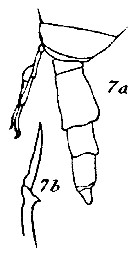 issued from : C. With in The Danish Ingolf-Expedition, Copepoda I, 1915, III, 4. [p.259, Pl. VIII, 7a, 7b]. Male: 7a, last thoracic segment with P5 and urosome (left lateral); 7b, tip of the right endopodite of P5.
|
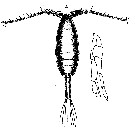 Issued from : T. Scott in Rep. Fishery Bd Scotl., 1902, 20 (3). [Pl. XXV, figs. 1-2]. Provisionally ascribed to Scolecithrix brevicornis. Male (from Shetland Islands): 1, habitus (dorsal); 2, P5. Nota: The P5 were slightly damaged, and the dzscription is to some extent imperfect: Left leg composed of 4 segments, the first is swollen but scarcely as long as the next, the 3rd and 4th, which are sub-equal, are also rather shorter ax well as being more slender than the second. Right leg with 3 (? or 4) segments, the 1st and 2nd moderately elongate, the 3rd is somewhat shorter and narrower, alongside of 3rd segment and articulated with it to the end of the 2nd is a slender branch-like appendage equal in length to the 3rd segment. Abdomen slender, scarcely half as long as thorax. A1 scarcely reaching to the 1st abdominal segment, the first 7 segments very short, the 8th to the (?) twelfth coalescent.
|
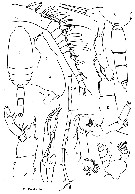 Issued from : O. Tanaka in Japanese J. Zool., 1937, VII, 13. [p.262, Pl. XVIII]. As Scaphocalanus minuta. Male (from coast of Heda, Japan): 1, habitus (dorsal); 2, forehead (lateral); 3, abdomen (lateral, right side); 4, left A1; 5, A2; 6, Md (palp); 7, Md (gnathobase); 8, P1; 9, P2 (exopod incomplete); 10, P5; 11, rostrum. Nota: - Cephalothorax: 1.48 mm; abdomen 0.73 mm. - Head and 1st thoracic segment fused, 4th and 5th thoracic segments fused. - Posterolateral corners of the last thoracic segment bluntly rounded. - Rostrum based on a knob produced from the anterior margin of the head; when viewed from the lateral the rostral filaments are slender. - Length of segments of the abdomen and caudal rami 5.4 : 27 : 14 : 18 : 2 : 85.4. Segments 2-4 inclusive are fringed with fine spines on the distal margin. - A1 19-segmented, extend to the end of the 3rd thoracic segment. A1 considerably bent posteriorly between the segments 14 and 15; segments 1-2, 8-1 fused; segments 20-21 fused on the right side; segments 24-25 completely fused on both sides. 1st basal segment of A2 with a row of hairs on the posterior surface; exopodite about 1.3 times as long as the endopodite. In Md, 2nd basipodite wider than its length. The other mouth appendages are less developed. P5 resemble that of S. magnus T. Scott; the terminal attenuated part of the right endopodite is articulated but it does not reach to the distal margin of the exopodite.
|
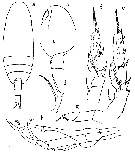 Issued from : O. Tanaka in Publ. Seto Mar. Biol. Lab., 1961, IX (1). [p.170, Fig.117]. Female (from Izu region, Japan): a, habitus (dorsal); b, forehead (lateral); c, last thoracic segment and genital segment (lateral); d, P2; e, P3; f, P5. Nota: Cephalothorax and abdomen in the proportional lengths 76 to 24. Head and 1st thoracic segment fused, 4th and 5th thoracic segments fused. Lateral corner of the last thoracic segment obtusely rounded when viewed from the side. Rostrum with an inflated base to which fairly long filaments are attached. Abdominal segments and caudal rami in the proportional lengths 34 : 21 : 19 : 10 : 16 = 100. A2 endopod 1.3 times as long as the exopod. Terminal segment of Mx2 with 3 long vermiform and 5 amalliform sensory filaments, of which 2 longer; setae on the 5th lobe slender. Mxp with a row of fine spinules on the anterior proximal margin. P5 2-segmented. Distal segment with 3 spines; the inner marginal spine about 1.5 times as long as the apical spine, rather coarsely denticulated on the distal outer margin (number of teeth about 17); the terminal spine about as long as the segment itself. The outer marginal spine arises oppositre to the inner marginal spine, and divides the outer margin of the segment in the proportions 3 : 1. Male: g, 1st segment of exopod of P2; h, P5. Nota: Cephalothorax and abdomen in the proportional lengths 64 to 36. Abdomen 5-segmented. Abdominal segments and caudal rami in the proportional lengths 6 : 37 : 20 : 24 : 5 : 8 = 100. A1 20-segmented, extends to the end of the 3rd thoracic segment. Segments 20 and 21 fused on the right side. P2 with a fairly long outer marginal spine on the 1st exopodal segment. The spine is slightly curved inwards. P5 reaches the distal end of the 2nd abdominal segment. Left leg with 3-segmented exopod and 2-segmented endopod. The distal segment of the endopod is small and turned at the apical portion. The endopod of the right leg styletform, reaches about the distal end of the 2nd basal segment of the left leg.
|
 Issued from : O. Tanaka in Publ. Seto Mar. Biol. Lab., 1961, IX (1). [p.170]. Female: Proportional lengths of degmenys of A1. A1 22-segmented, extends ti the posterior margin of the last thoracic segment. The 1st segment furnished with a row of minute spine on the posterior distal margin. Segments 8, 12, 14 and 18 have each 2 setae; 10 with a distal seta.
|
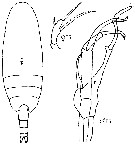 Issued from : J.M. Bradford-Grieve, E.L. Markhaseva, C.E.F. Rocha & B. Abiahy inSouth Atlantic Zooplankton, Edit. D. Boltovskoy, 1999, Vol. 2. [p.1025, Fig. 7.196]. Female: habitus and P5. Male: P5 (l = left leg; r = right leg).
| | | | | Ref. compl.: | | | ? Hardy & Gunther, 1935 (1936) (p.165 , Rem.); Sewell, 1948 (p.349, 496, 502, 514); Østvedt, 1955 (p.15: Table 3, p.69); M.W. Johnson, 1963 (p.89, Table 1, 2); Furuhashi, 1966 a (p.295, vertical distribution in Oyashio/Kuroshio regions, Table 6, 7, 10); Harding, 1966 (p.17, 66, 71); Grice & Hulsemann, 1965 (p224); 1967 (p.16); Dunbar & Harding, 1968 (p.319, 320); Vinogradov, 1968 (1970) (p.261); Shih & al., 1971 (p.152); Roe, 1972 (p.277, tabl.1, tabl.2); 1972 b (p.535); ? Björnberg, 1973 (? part., p.331, 389); Deevey & Brooks, 1977 (p.256, tab.2, Station "S"); Buchanan & Sekerak, 1982 (p.41, vertical distribution); Vives, 1982 (p.292); Guangshan & Honglin, 1984 (p.118, tab.); Mackas & Anderson, 1986 (p.115, Table 2); Lozano Soldevilla & al., 1988 (p.58); Shih & Marhue, 1991 (tab.2, 3); Hattori, 1991 (tab.1, Appendix); Richter, 1994 (tab.4.1a); Padmavati & al., 1998 (p.349); Kosobokova & al., 1998 (tab.2); Kosobokova & Hirche, 2000 (p.2029, tab.2); Holmes, 2001 (p.58); Ringuette & al., 2002 (p.5081, Table 1); Auel & Hagen, 2002 (p.1013, tab.2); Sameoto & al., 2002 (p.13); Hsiao & al., 2004 (p.326, tab.1); Shimode & al., 2005 (p.113 + poster); Somoue & al., 2005 (Table I: p.68); Berasategui & al., 2005 (p.313, fig.2); Hopcroft & al., 2005 (p.198, table 2); Kuriyama & Nishida, 2006 (p.299: Tab.II; p.309: Tab.III, fig.7, 10, vertical distribution); Hop & al., 2006 (p.182, Table 4); Deibel & Daly; 2007 (p.271, Table 1, Rem.: Arctic polynyas); Blachowiak-Samolyk & al., 2007 (p.2716, Table 2); Dur & al., 2007 (p.197, Table IV); Blachowiak-Samolyk & al., 2008 (p.2210, Table 3, biomass); Gaard & al., 2008 (p.59, Table 1, N Mid-Atlantic Ridge); Lan Y.-C. & al., 2008 (p.61, Table 1, % vs stations); Galbraith, 2009 (pers. comm.); Park & Ferrari, 2009 (p.143, fig.2, biogeography); Kosobokova & Hopcroft, 2010 (p.96, Table 1, fig.7); Schnack-Schiel & al., 2010 (p.2064, Table 2: E Atlantic subtropical/tropical); Bucklin & al., 2010 (p.40, Table 1, Biol mol.); Dvoretsky & Dvoretsky, 2010 (p.991, Table 2); Kosobokova & al., 2011 (p.29, Table 2, figs.4, 8, Rem.: Arctic Basins); Hsiao S.H. & al., 2011 (p.475, Appendix I); Homma & al., 2011 (p.29, Table 3, abundance, feeding pattern: detritivores); Sano & al., 2013 (p.11, Table 2, fig.5, feeding habits); Bonecker & a., 2014 (p.445, Table II: frequency, horizontal & vertical distributions); Smoot & Hopcroft, 2016 (p.1, fig.7, vertical distribution); El Arraj & al., 2017 (p.272, table 2, seasonal composition); Dias & al., 2019 (p.1, Table II, IV, occurrrence, vertical distribution). | | | | NZ: | 13 + 3 douteuses | | |
|
Carte de distribution de Scaphocalanus brevicornis par zones géographiques
|
| | | | | | | | | | | | | Loc: | | | ? Antarctic (Indian sector), South Georgia, S Morocco, Canary Is., Bay of Biscay, Argentina (inBerasategui & al., 2005), Brazil, off Rio de Janeiro, The Campos Basin, , off Amazon, off Bermuda: Station ‘’ S’’ (32°10’N, 64°30’W), Sargasso Sea, Chesapeake Bay, off E Nova Scotia, W Baffin Bay, Fram Strait, Spitsbergen, Greenland, S Ireland , off W Ireland off E Shetland Is., Faroe Is., Norway Sea, Norway, Barents Sea, Arct. (Polar Basin, Laptev Sea, Fletcher's Ice Is., Lomonosov Ridge, Chukchi Sea, Nanden Basin, Amundsen Basin, Makarov Basin, Canada Basin, Beaufort Sea), Arabian Sea, W Indian, Philippines, China Seas (East China Sea, South China Sea), 25°30'N-123°E, Taiwan (SW, E, NW), Japan (Sagami Bay, Suruga, off Sanriku), off SE Hokkaido, S Aleutian Is., British Columbia, Fjord system (Alice Arm & Hastings Arm), Portland Inlet, Pacif. (W equatorial), ? Chile (N & S) | | | | N: | 69 | | | | Lg.: | | | (7) F: 2,23; M: 2,5; (22) F: 2,1-1,9; M: 2,6; (38) F: 2,6-2; (65) F: 2; ? (108) F: 2,66-2,44; M: 2,99-2,15; (128) M: 2,21; (199) F: 2,43-2,2; M: 2,58-1,9; (1000) F: 2,2 ± 0,2; M: 2,7 ± 0,7; (1129) M: 1,5; {F: 1,90-2,66; M: 1,50-3,40} | | | | Rem.: | méso-bathypélagique.
Bradford & al. (1983) n’ont pas eu connaissance du travail de Park (1982).
Toutes les localisations antiboréales concernant cette forme sont attribuées à Scaphocalanus farrani; un doute subsiste en ce qui concerne les identifications au large du Brésil et d'Argentine, comme en Antarctique et en Georgie du Sud.
Voir aussi les remarques en anglais | | | Dernière mise à jour : 25/10/2022 | |
|
|
 Toute utilisation de ce site pour une publication sera mentionnée avec la référence suivante : Toute utilisation de ce site pour une publication sera mentionnée avec la référence suivante :
Razouls C., Desreumaux N., Kouwenberg J. et de Bovée F., 2005-2025. - Biodiversité des Copépodes planctoniques marins (morphologie, répartition géographique et données biologiques). Sorbonne Université, CNRS. Disponible sur http://copepodes.obs-banyuls.fr [Accédé le 28 novembre 2025] © copyright 2005-2025 Sorbonne Université, CNRS
|
|
 |
 |












